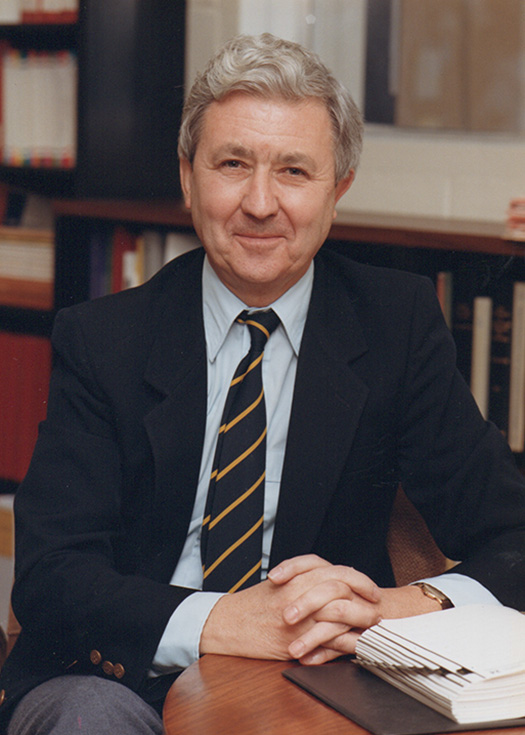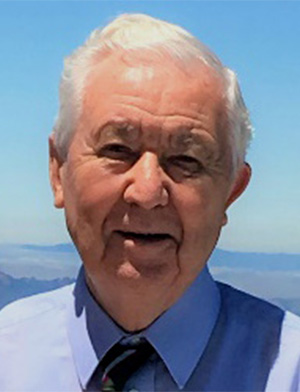In Memoriam: Ralph Harold Thomas
1932-2017
by Robert May, CHP, and Linnea Wahl, CHP


Ralph Harold Thomas was "truly a founder of the field of health physics: a consummate scientist whose long list of accomplishments over a lifetime dedicated to radiation protection has laid the foundation for excellence in health physics," as we wrote in his 2011 Founders Award citation. More than that, however, Ralph was a man of the highest personal and professional integrity—a superlative health physicist and a perfect gentleman.
Born in 1932, Ralph called this "the annus mirabilis when Chadwick announced the discovery of the neutron and Cockcroft and Walton in Cambridge and Lawrence and Livingston in Berkeley announced their seminal experiments with the new particle accelerators."
Ralph was just 15 when he began working at the first nuclear reactor in Western Europe at Harwell, England. He went on to graduate with honors in physics from University College, London (now a member institution of the University of London), and the following year he was awarded a PhD in nuclear physics from that same institution. After his marriage to Mavis Waldgrave in 1958, Ralph joined the newly established Rutherford Laboratory in Harwell in 1960.
In 1968, Ralph and Mavis moved to California in search of better opportunities for their family (which now included young Simon, Shelagh, and Susan). And indeed, Ralph made the most of those opportunities, spending time at Stanford University, serving ultimately as a division director at the University of California's Radiation Laboratory in Berkeley (now Lawrence Berkeley National Laboratory), and finishing his career at Lawrence Livermore National Laboratory, where he rose to the position of department head. He retired from the University of California after 25 years of service. Throughout his career, Ralph worked with, and introduced his family to, many Nobel Laureates.
While at Berkeley, Ralph's research in high-energy physics was recognized internationally, and he traveled and lectured widely in the United States, Europe, and Asia. Among many important contributions during this time, Ralph was consulted on the nuclear reactor incident at Three Mile Island.
Ralph was a man of letters. In addition to his PhD in nuclear physics, Ralph was awarded a DSc by the University of London for his expertise in radiation protection and his lifetime body of work. Furthermore, as his daughter Susie puts it, "Dad earned a master's degree in public health from the University of California [Cal] 'just for fun' while Shelagh was an undergraduate at Cal," where Ralph taught doctoral physics at the Berkeley School of Public Health. He was awarded a master's degree from the University of Oxford, where he was honored as a visiting Fellow of Keble College. During that sabbatical year, Ralph was also consulted on the reactor incident at Chernobyl.
Not just an impeccable scientist, Ralph was also known for his great skill with the English language. Aside from mentoring many colleagues in technical topics, he frequently tutored those he mentored in better use of the "Queen's English." While serving on the editorial boards of the journals Health Physics and Radiation Protection Dosimetry, Ralph significantly improved the scientific literature in radiation protection by helping authors write more readable and understandable prose.
Ralph was also a man of conviction who supported his profession, serving continuously for more than 20 years on committees of the International Commission on Radiological Protection, the International Commission on Radiation Units and Measurements, and the National Council on Radiation Protection and Measurements (NCRP). Among others, accelerator health physicists are indebted to Ralph for NCRP Report No. 144, Radiation Protection for Particle Accelerator Facilities.
Ralph joined the Health Physics Society (HPS) in 1968 and served the Society in various national and local positions. He filled so many volunteer positions that it is difficult to list them all, but a few that stand out include his service as HPS treasurer and director, founding member and the first president-elect of the HPS Accelerator Section, associate editor of Health Physics Journal, chair of the HPS Publications Committee, G. William Morgan lecturer, and guest lecturer for the Sierra Nevada Chapter annual J. Newell Stannard Lecture Series.
He received many professional awards, including the HPS Fellow designation, the 2004 HPS Distinguished Scientific Achievement Award, and the prestigious 2011 HPS Founders Award. This latter award was especially poignant for Ralph inasmuch as his longtime colleague and friend, H. Wade Patterson, also received the award in 1983. Ralph and Wade can clearly be considered as two chief founders of accelerator health physics.
Writing on Ralph's HPS Founders Award presentation, we penned:
During his years at the national laboratories, Ralph assumed ever-increasing management responsibilities while continuing his research. He conducted radiation studies for the design of many high-energy accelerators and participated in the first acceleration of high-energy heavy ions at the Bevatron.
His other studies included the production of tagged neutron beams, Apollo Mission eye-flash experiments, radiobiological experiments with heavy ions, the environmental radiological impact of accelerators, and the measurement of radiation fields in the cabin of NASA [National Aeronautics and Space Administration] aircraft flying at high altitudes.
His scientific publications include more than 200 papers and a dozen books, including the textbook Accelerator Health Physics, written jointly with H. Wade Patterson, which stands out not only as the first comprehensive textbook on accelerator health physics, but as a classic in radiation protection literature.
Ralph and Wade also organized (as editors) and contributed to (as authors) the fascinating book A History of Accelerator Radiological Protection: Personal and Professional Memoirs.
And Ralph was a man of many passions. His interests outside of work included gardening, classical music, reading, and spending hours and hours transforming his California home into an English country garden. Ralph and Mavis were season ticket holders for Cal football and basketball. They loved the Cal marching band, of which daughter Shelagh, son-in-law Steve, and daughter Susie were members. Ralph was an avid reader and lifelong student, amassing a library of over 5,000 books on a variety of topics, all of which he read with passion. He also amassed a large collection of music recordings from Gregorian chants to mid-20th century composers. He imparted his love of music to his children, encouraged his children in school, and introduced them and his nine grandchildren to history, math, science, music, and the arts, faithfully attending his children's and grandchildren's concerts, plays, and sporting events.
Ralph was a devoted adherent to the Christian faith as expressed by the Roman Catholic Church while maintaining a phenomenal openness to those holding other beliefs. It was this faith that sustained him through the loss of his dear wife Mavis in 2005 after 47 years of marriage.
Ralph Thomas's contributions to the profession of health physics and to the HPS cannot be overstated. Those whom he has mentored over the years have been treated to a relationship with a man whose scientific and technical acumen and personal integrity were unsurpassed. This man of letters, conviction, and passion will be deeply missed.
Authors' note: Written on behalf of a grateful accelerator health physics community and with many thanks for contributions from Susan (Thomas) Homer, J. Donald Cossairt, Mike Grissom, Joe McDonald, and Genevieve Roessler.




